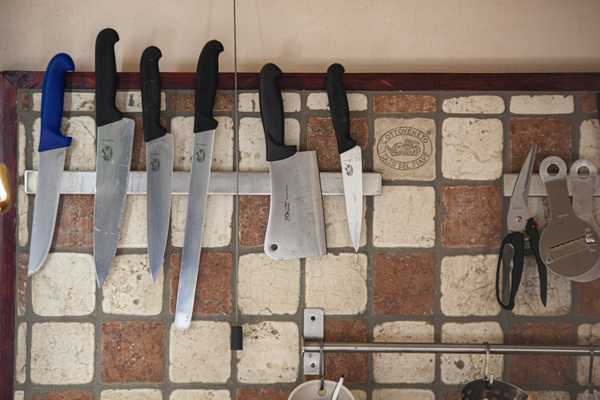If cutting up a chicken is hard, clumsy work, or you find yourself cursing your carrots when you attempt to matchstick them, I have the most likely reason: your knives probably suck.
Slicing and dicing should be fun. When you have good knives and you keep them sharp, they are a joy to use.
There’s another consideration: dull knives are dangerous. Pushing through a cut means you might slip. Slipping means you might cut yourself. That’s bad. When it comes to choosing and caring for knives, remember to keep safety first.
Contents
Knife Sets: Avoid ’Em
What are the best knives for home cooking? My first piece of advice is to forget about knife sets. They usually include several shapes you’ll never use, just there to fill up the knife block. Cheap knife sets are often useless. Expensive knife sets might include some great knives you’ll use often, but with the additional cost of some obscure shapes you never find yourself using.
Buy your knives one at a time, choosing each carefully. You don’t need many, but each one should be the best you can afford. You should like to look at it; you should like the feel of it in your hand. Knives are integral in cooking. The more you like yours, the more you’ll enjoy making food.
6-Inch Chef’s Knife
Expect to pay $50 to $100 for this. It’s perhaps the single most used tool in your entire kitchen. Look for a solid piece of high-carbon stainless steel. Wusthof and J.A. Henckels are terrific brands that you can’t go wrong with.
Get a good diamond or ceramic knife sharpener, and use it often—weekly, at least. Many articles and cooking shows will warn you against sharpening your own knives. I say, get the tools you need and learn to do it yourself. I’ve been sharpening my own knives since I was a teenager. You can do it, it. Besides, if you sharpen your own knives every week or so, that’s got to be better than sending knives out to be sharpened every year or whatever. How can it be right to let knives go that long without sharpening? Even if you do make use of the services of a professional, tend to your own knives in between times.
You can get away with paying less for a chef’s knife if you shop at a restaurant supply store. There you’ll be able to find a trusty workhorse brand, like Dexter Russell, that will hold an edge as well have a sturdy blade. We have a 7-inch Dexter Russell that I like to use on bigger items, like heads of cabbage. For smaller things like onions, I find our 6-inch Wusthof to be ideal.
For goodness sake, don’t use a serrated knife to tear at your meat and veggies; it’s a lot more work, and you don’t have as much control over the cut. That means you can’t cut paper thin as you’d like, and you’re more likely to slip and cut yourself.
9-Inch Or 10-Inch Serrated Bread Knife
A bread knife has a long blade that’s more or less oblong in shape, as opposed to triangular and tapering like a chef’s knife’s blade. Serrated teeth are appropriate on this shape of knife, as they saw through bread with ease. The teeth of a serrated blade grip and the scalloped indentations reduce the amount of friction, so that the knife doesn’t bind as you’re trying to cut. Serrated knives are good on materials that are very soft, so that you don’t distort them as you cut through them.
3 1/2-Inch Or 4-Inch Paring Knife
A paring knife will be something you find yourself reaching for often, so get a good one. You can splurge on a pricey one ranging from $30 to $50, or find one for under $5 at a restaurant supply store. The pricey one will last a lifetime and will likely feel really good in your hand. A restaurant supply version can last for years in a home kitchen, where it won’t be given the workout and rough treatment that it would get in a restaurant
